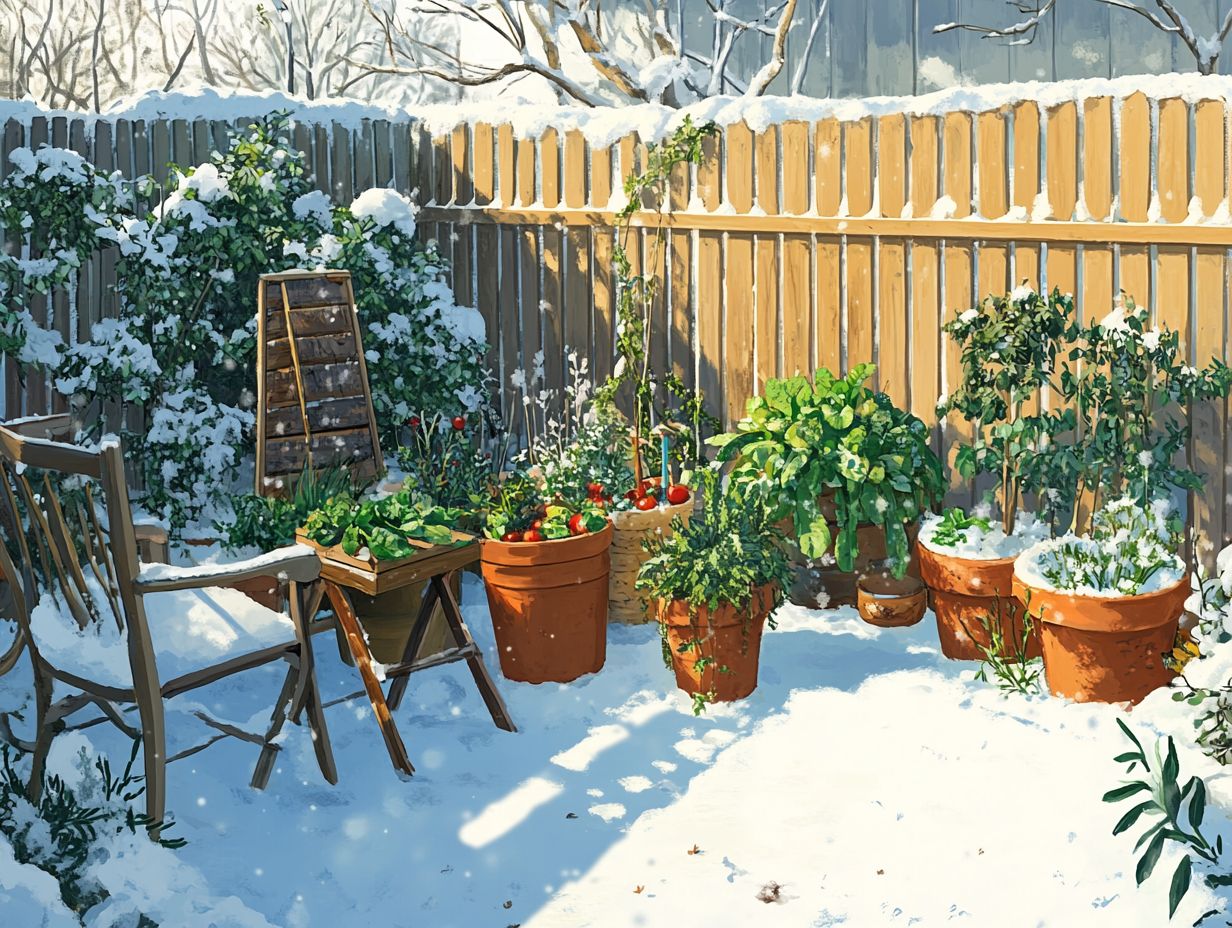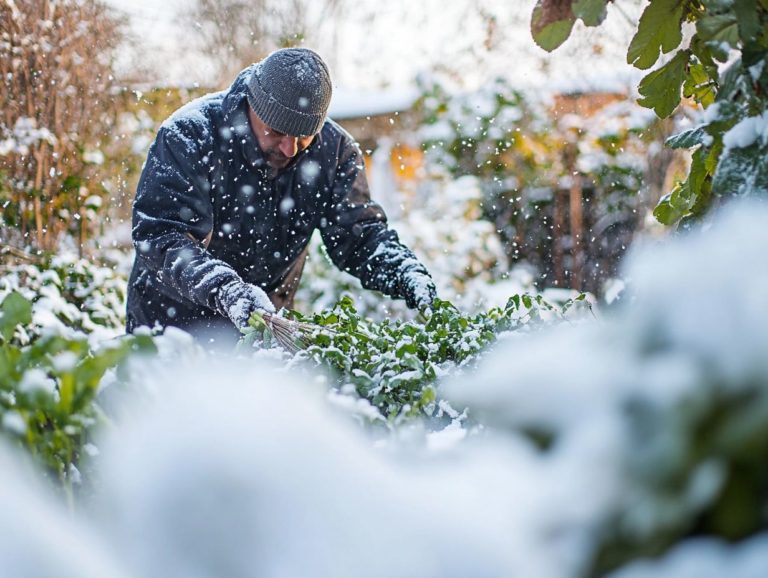Choosing the Right Location for Winter Gardening
Winter gardening may seem challenging at first. However, it offers an amazing chance to grow beauty and food in the cold.
This exploration delves into the many benefits of winter gardening. From the satisfaction of harvesting your own food to the delight of adding color to a dreary landscape, there s a lot to enjoy.
Key factors to consider include selecting the ideal location, preparing your space well, and choosing the right plants that can thrive despite the chill.
Whether you re a seasoned gardener or a curious beginner, dive into winter gardening! It s not just rewarding; it s an adventure waiting for you.
Contents
Key Takeaways:

- Choose your winter garden spot based on climate, sunlight, and soil quality.
- Opt for greenhouses, hoop houses, or indoor spaces for the best winter gardening results.
- Select cold-tolerant plants like vegetables, herbs, and flowers for a colorful and productive winter garden.
Benefits of Winter Gardening
Winter gardening provides numerous benefits, allowing you to extend your growing season beyond the usual limits. You can enjoy the satisfaction of home-grown vegetables even during colder months.
By using techniques such as cold frames, cloches, and row covers, you can protect your plants from harsh winter weather. This ensures that your backyard garden stays productive throughout the season.
Winter gardening also helps keep nutrients in the soil, supports community gardening initiatives, and enriches your overall gardening experience. It deepens your connection to nature a sentiment championed by experts from the Rutgers Cooperative Extension.
Why Garden in the Winter?
Gardening in winter can be a rewarding experience that allows you to cultivate fresh vegetables and maximize your gardening potential. Imagine the excitement of heating up a greenhouse or planting in cold frames.
Winter opens the door to unique gardening techniques that aren’t typically practiced in warmer seasons. You might find joy in growing hardy crops like kale, spinach, and root vegetables such as carrots and beets, which thrive in cooler temperatures.
Engaging with plants during this time can serve as a therapeutic retreat from the chill outside. It offers a peaceful yet productive space for reflection and creativity. Ultimately, winter gardening enhances food sustainability and provides a fulfilling emotional outlet, helping you combat those seasonal blues.
Factors to Consider Before Choosing a Location
Before you embark on your winter gardening adventure, consider several key factors: the quality of your garden soil, the amount of sunlight your space receives, and how to choose the right winter garden variety based on the specifics of your local climate.
These elements will significantly affect the success of your winter garden and the types of vegetable varieties you can grow. By ensuring optimal conditions for plant growth, you can reduce the risk of plant diseases and prepare for a flourishing garden season.
Climate and Hardiness Zone
Knowing your local weather and the best plants for your area is key for winter gardening. This knowledge helps you choose which vegetable varieties can thrive in your environment, and planning your winter vegetable garden layout can further enhance your gardening success.
For instance, in USDA Hardiness Zone 3, you may find that cold-tolerant crops like kale and spinach not only survive but actually flourish even after frost. In warmer zones, like Zone 7, you can enjoy a broader selection, including carrots and beets, which also thrive in chilly nights.
By considering these factors, you can confidently choose the right vegetable varieties that will not only survive but also provide a bountiful harvest. This maximizes the advantages of your seasonal climate.
Start planning your winter garden today for a fresh and vibrant harvest this season!
Available Sunlight
Available sunlight is a crucial element in determining the success of your winter garden, as it directly impacts plant growth and development.
Understanding how to assess the sunlight in your gardening area is essential. You can use a simple light meter or observe your surroundings at different times throughout the day, taking note of the shadows cast by trees or buildings. This awareness helps you plan the placement of various vegetable varieties more effectively, ensuring they receive the optimal amount of sunlight.
Recognizing unique areas with different light, temperature, and moisture levels allows you to make informed adjustments in plant placement, enhancing productivity. By leveraging these insights and following tips for sustainable winter gardening, you can cultivate a flourishing winter garden brimming with healthy, productive plants.
Soil Quality

High-quality garden soil is crucial for your winter gardening endeavors. It provides the essential nutrients and structure your plants need to thrive.
Several factors significantly influence soil quality, particularly the organic matter content. This content is vital for enhancing soil structure and promoting moisture retention. The soil s ability to retain nutrients determines how effectively it supports plant life over time.
If you’re eager to improve your soil, incorporating homemade fertilizer and compost can work wonders. These natural materials not only enrich the soil but also enhance microbial activity, fostering a vibrant ecosystem that nurtures winter crops and ensures robust growth, even in the chill of winter.
Best Locations for Winter Gardening
Choosing the optimal locations for winter gardening can significantly elevate your gardening experience. Whether you opt for greenhouses, hoop houses, cold frames, or even indoor spaces, each option presents distinct advantages that bolster plant growth and shield against the rigors of winter. To make an informed decision, explore how to choose the best location for winter crops.
Greenhouses and Hoop Houses
Greenhouses and hoop houses offer an exceptional environment for winter gardening. They enhance sunlight exposure while shielding your plants from the harsh chill of winter.
These structures create a controlled atmosphere that keeps your plants warm and dry. This is essential for their growth during the colder months. By capturing and maximizing sunlight, they promote longer growing seasons and healthier crops. Many gardeners successfully use these setups to cultivate a diverse range of plants, including leafy greens like spinach and kale, which thrive in these pleasantly warm conditions.
Some enthusiasts have even reported impressive yields of tomatoes and peppers, defying the odds in frost-prone regions. Online resources, such as gardening blogs and forums, abound with testimonials from individuals who have revolutionized their gardening experiences by embracing these eco-friendly enclosures.
Cold Frames
Cold frames serve as an invaluable asset for your winter gardening endeavors. They create a microclimate that retains heat and extends the growing season for a variety of vegetables.
By trapping warmth from the sun, these straightforward structures enable you to cultivate plants well past the usual frost date. This makes them perfect for those enthusiastic about seasonal gardening. The design of cold frames typically features a transparent cover often crafted from glass or heavy-duty plastic that maximizes sunlight exposure while shielding delicate plants from harsh winds and snow.
As a result, it s little wonder that leafy greens, root vegetables, and certain herbs flourish in these environments, enjoying the regulated warmth and protection that cold frames provide.
Indoor Spaces
Indoor spaces can be your secret weapon for winter gardening. They allow you to grow vegetables in controlled conditions.
By using LED grow lights or fluorescent bulbs, you can create the perfect environment when sunlight is low. Container gardening gives you flexibility with different pot sizes tailored to your plants.
Maintaining the right moisture levels is crucial. Use self-watering pots or humidity trays for a consistent water supply.
Indoor gardening during winter is a rewarding endeavor. You can enjoy fresh produce right at your table!
Preparing the Chosen Location
Preparing your location for winter gardening involves several essential steps. Start by clearing the area of debris.
Next, prep the garden soil to provide a solid foundation for your plants. Enriching the soil will help them thrive.
Finally, add insulation and protective measures for your plants during cold months. This keeps them vibrant and strong.
Clearing and Prepping the Area

Clearing and prepping the area is your first step for a successful winter garden. This lays the groundwork for healthy plant growth.
Remove weeds and debris to create a clean slate. This also reduces nutrient competition.
Improve soil structure by adding organic matter like compost. This boosts fertility and drainage.
Practicing mulching regulates temperature and moisture. This helps protect your soil during winter.
Adding Insulation and Protection
Adding insulation and protection to your winter garden is essential. This keeps your plants safe from extreme temperatures.
Use cloches for a mini-greenhouse effect or row covers for warmth. These methods retain heat and protect against frost.
Don’t forget to use mulch to insulate the soil. This keeps root systems healthy.
By integrating these measures, you nurture your plants to thrive all winter long.
Choosing the Right Plants for Winter Gardening
Selecting the right plants is essential for winter gardening. For better productivity, consider choosing the right tools for winter gardening, focusing on cold-tolerant vegetables and herbs.
Cold-Tolerant Vegetables and Herbs
Cold-tolerant vegetables and herbs give you great options for winter gardening. Many can thrive in lower temperatures.
Hardy varieties like kale and spinach withstand frost and continue to grow. Carrots sweeten after a cold spell, enhancing your winter meals.
Perennial herbs like thyme and parsley survive the chill, offering fresh flavors even during frosty weather.
Incorporating these plants into your garden extends your season and ensures fresh produce all winter!
Flowers and Ornamentals for Winter Color
Flowers and ornamentals add color to your winter garden. They enhance the visual appeal of your otherwise dormant landscape.
Consider winter-blooming plants like the striking hellebores and cheerful winter jasmine. These plants serve as captivating focal points amidst the stark branches and muted earth tones.
Evergreens, such as holly or ornamental grasses, provide both structure and texture, ensuring your garden remains visually engaging throughout the chilly months.
Using techniques like layering, which means placing taller plants behind shorter ones, can enhance the depth and dimension of your garden, transforming it into an enchanting space. Seasonal practices, like adding mulch, help protect the soil and keep plants healthy.
Frequently Asked Questions
What is winter gardening and why is it important to choose the right location?

Winter gardening refers to the practice of growing plants during the colder months of the year. Choosing the right location is crucial for successful winter gardening, and selecting plants for a winter garden significantly impacts the health and growth of your plants.
What factors should I consider when choosing the right location for winter gardening?
Important factors include the amount of sunlight the location receives, the type of soil, and protection from harsh winter conditions such as wind and snow.
Can I use the same location for winter gardening as I do for summer gardening?
It is not recommended to use the same location for both summer and winter gardening. Winter gardening requires different conditions, such as more sunlight and protection from wind, which may not be suitable for summer plants. For guidance on what to plant, consider choosing the right vegetables for winter.
What are some suitable locations for winter gardening?
Suitable locations for winter gardening include south-facing slopes, areas near heat-reflecting walls or structures, and sheltered spots in your garden that receive adequate sunlight. For more insights, check out this guide on how to choose the right location for a cold garden.
Can I still practice winter gardening if I live in a colder climate?
Yes, you can still practice winter gardening in colder climates. However, it’s important to choose a location that offers protection from harsh winter conditions and consider understanding microclimates for winter gardening to select cold-hardy plants that can withstand freezing temperatures.
Are there any plants that are particularly well-suited for winter gardening?
Yes, many plants thrive in winter conditions, such as kale, spinach, and Brussels sprouts. Excitingly, these cold-hardy plants can keep growing and even give you fresh crops all winter long!
Ready to brighten up your winter garden? Start planting today!






